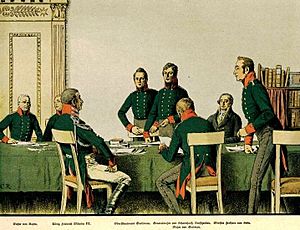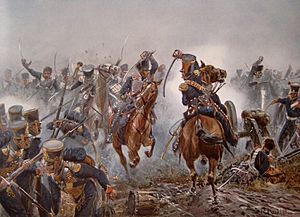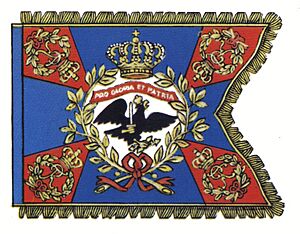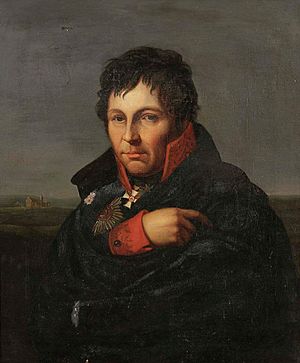Royal Prussian Army of the Napoleonic Wars facts for kids
The Royal Prussian Army was the main army of the Kingdom of Prussia during the Napoleonic Wars. After the famous Frederick the Great, his nephew Frederick William II became king (1786–1797). He wasn't very interested in war and let the army's quality drop. The Prussian Army, still using old training and weapons from 40 years earlier, was not ready for the changes happening in Revolutionary France. France, especially under Napoleon Bonaparte, was creating new ways to organize, supply, and command its forces.
Prussia left the war against France in 1795 with the Peace of Basel, giving up some land to France. By the time Frederick William II died in 1797, Prussia was broke, and its army was old-fashioned.
Contents
War of the Fourth Coalition (1806–1807)
Frederick William III became king in 1797. He led Prussia into the terrible Fourth Coalition war. The Prussian Army suffered huge defeats in the battles of Saalfeld, Jena, and Auerstedt in 1806. The Prussians, known for their discipline, started surrendering in large numbers.
Even though some Prussian commanders fought well, like L'Estocq at Eylau and Blücher at Lübeck, it wasn't enough. Prussia had to give up a lot of land and was only allowed to have an army of 42,000 men. They also had to become allies with France in the Treaty of Tilsit in 1807.
Army Reforms

The army's defeat was a big shock to Prussia, which had felt unbeatable after Frederick the Great's victories. While Stein and Hardenberg started to modernize the Prussian government, Scharnhorst began to reform the military. He led a committee with other important people like Gneisenau and Clausewitz. They wanted to make Prussians more patriotic after the defeats of 1806. Stein's reforms ended serfdom (a type of forced labor) in 1807.
Many old generals were replaced. The army also started allowing middle-class people to become officers in 1808. To get promoted, officers now needed to be well-educated. King Frederick William III created the War Ministry in 1809. Scharnhorst also started an officer training school in Berlin in 1810, which later became the Prussian War Academy.
Scharnhorst wanted to use levée en masse, which was a system of military conscription (drafting citizens) like France used. He created the Krümpersystem, where companies would train a few new soldiers each month. This allowed Prussia to secretly train a large reserve army of 30,000 to 150,000 extra troops. This system also started short-term military service in Prussia, instead of the long-term service used before. Because the French didn't want Prussia to have large armies, the Prussian Army was divided into six brigades.
Most physical punishments for soldiers were stopped. Soldiers were trained in the field and learned new fighting styles. Scharnhorst also pushed for different parts of the army, like infantry, cavalry, and artillery, to work together. Equipment and tactics were updated to match Napoleon's fighting methods. A new field manual in 1812 emphasized working together and faster marches. In 1813, Scharnhorst made sure that each field commander had a chief of staff trained at the academy.
Some traditional officers, like Yorck, didn't like these changes. They worried that middle-class officers would take away the privileges of the noble officers and bring in ideas from the French Revolution. Scharnhorst died in 1813, and the push for a more democratic army slowed down.

Many people wanted King Frederick William III to join the Austrian Empire in its 1809 fight against France. But the king was careful and refused. So, Schill led his hussar regiment against the French, hoping to start a national uprising. The king saw Schill as a rebel, and Schill's uprising was crushed by French allies.
French Invasion of Russia (1812)
In 1812, a treaty forced Prussia to provide 20,000 troops for Napoleon's huge army, the Grande Armée. The French still occupied Prussia, and 300 Prussian officers quit in protest.
When Napoleon's army retreated from Russia in 1812, General Yorck made his own deal with Russia, called the Convention of Tauroggen. This broke Prussia's alliance with France. Stein arrived in East Prussia and helped create the Landwehr (a citizen militia) to defend the area. Since Prussia was now clearly joining the Sixth Coalition against France, Frederick William III quickly started to mobilize the army. The Landwehr system was copied across the country. Unlike in 1806, the Prussian people, especially the middle class, strongly supported the war. Thousands of volunteers joined the army. Prussian troops, led by Blücher and Gneisenau, were very important in the Battles of Leipzig (1813) and Waterloo (1815).
The Iron Cross was created as a military decoration by King Frederick William III in 1813. After he published his book On War, Clausewitz became a very important thinker about war.
Wars of Liberation
The Prussian, and later German, General Staff was officially created in 1814. This group of military experts helped plan and organize the army. In the same year, Boyen and Grolman wrote a law for universal conscription. This meant all men would serve in the standing army, then the Landwehr (militia), and finally the local Landsturm (home guard) until they were 39. Soldiers in the 136,000-strong standing army served for three years and were in the reserves for two. Militiamen in the 163,000-strong Landwehr served a few weeks each year for seven years.
The Convention of Tauroggen was the start of Prussia's comeback. As news spread about Napoleon's army being destroyed in Russia, the Prussian people, who had suffered under French rule for years, became very angry and determined. The king and his ministers were worried, but the Russians and the Prussian soldiers wanted to keep fighting. They pressured the government to help supply the troops. Soon, French soldiers scattered across the country were surrounded or forced to retreat.
Hundred Days
Prussian Army (Army of the Lower Rhine)
This army was made up entirely of Prussians. Field Marshal Gebhard Leberecht von Blücher commanded this army, with General August Neidhardt von Gneisenau as his chief of staff.
Blücher's Prussian army had 116,000 men. It was divided into four main groups, called corps:
- I Corps (Graf von Zieten), with 30,800 soldiers, was near Charleroi.
- II Corps (Pirch I), with 31,000 soldiers, was near Namur.
- III Corps (Thielemann), with 23,900 soldiers, was near Ciney.
- IV Corps (Bülow), with 30,300 soldiers, was near Liège.
German Corps (North German Federal Army)
This army was part of the larger Prussian Army but acted on its own, further south. It included soldiers from different German states. Blücher ordered this army to march north to join his main force because he feared Napoleon would attack first. General Friedrich Graf Kleist von Nollendorf first led this army, but General Von Engelhardt took over later. It had about 25,000 soldiers.
Prussian Reserve Army
Besides the four army corps that fought in the Waterloo Campaign, Prussia also had a reserve army at home to protect its borders. This army included:
- V Army Corps – Led by General Ludwig Yorck von Wartenburg
- VI Army Corps – Led by General Bogislav Friedrich Emanuel von Tauentzien
- Royal Guard (VIII Corps) – Led by General Charles II, Grand Duke of Mecklenburg-Strelitz
Organization of the Royal Prussian Army
Staff System
The Prussian General Quartermaster Staff was first created by Frederick William III in 1803. Its job was to create plans for battles and make detailed maps. From 1808, they also studied past wars and thought about future battle situations. In 1810, Frederick William ordered that staff officers should work with different army branches to learn practical soldiering skills. When the army was called to action, these staff officers would then help the generals.
Ranks of the Prussian Army
This chart shows the ranks for infantry, cavalry, and light infantry in the Royal Prussian Army from 1808 onwards. The ranks are in the German used at that time.
| Prussian Line Infantry Rank | Cavalry Equivalent | Light Infantry Equivalent |
|---|---|---|
| General-Feldmarschall | N/A | N/A |
| General der Infanterie | General der Cavalerie | N/A |
| General-Lieutenant | N/A | N/A |
| General-Major | N/A | N/A |
| Oberst | Oberst | N/A |
| Oberst-Lieutenant | Oberstlieutenant | N/A |
| Major | Major | Major |
| Capitän | Rittmeister | Hauptmann |
| Premier-Lieutenant | Premier-Lieutenant | Premier-Lieutenant |
| Seconde-Lieutenant | Seconde-Lieutenant | Seconde-Lieutenant |
| Fähnrich | Fähnrich | Fähnrich |
| Feldwebel | Wachtmeister | Feldwebel |
| Sergeant | Unterwachtmeister | Sergeant |
| Unterofficer | Unterofficier | Unterofficier |
| Gefreiter | Gefreiter | Oberjäger/Oberschütze |
| Soldat (i.e. Musketier, Grenadier, etc.) | Reiter | Jäger/Schütze |
The King (König) could also be a military commander.
Organization of Army
Royal Guard
As of 1813, the Royal Prussian Army's Royal Guard included these regiments:
| Regiment Name | In Contemporary German | Regimental Role |
|---|---|---|
| 1st Guard Regiment on Foot | 1. Garde-Regiment zu Fuß | Guard infantry, 2 guard grenadier battalions and 1 fusilier battalion. |
| 2nd Guard Regiment on Foot | 2. Garde-Regiment zu Fuß | Guard infantry, 3 guard grenadier battalions |
| Guard Hunter Battalion | Garde-Jäger-Bataillon | Guard riflemen, 1 battalion of riflemen |
| Regiment of Guard Foot Artillery | Garde-Fuß-Artillerie-Regiment | Guard foot artillery, 2 batteries |
| Battery of Guard Horse Artillery | Garde-Reitende-Artillerie-Batterie | Guard horse artillery, 1 battery |
| Horse Guards | Regiment der Gardes du Corps | Guard heavy cavalry, 4 squadrons |
The following regiments were created after Napoleon was sent away in 1815. The two grenadier regiments were formed in 1814 by combining smaller battalions.
| Regiment Name | In Contemporary German | Regimental Role |
|---|---|---|
| Guard Riflemen Battalion | Garde-Schützen-Bataillon | Guard riflemen, 1 battalion of riflemen |
| Guard Uhlan Regiment | Garde-Ulanen-Regiment | Guard lancer cavalry, 2 squadrons |
| Guard Hussar Regiment | Garde-Husaren-Regiment | Guard hussars, 2 squadrons |
| Guard Dragoon Regiment | Garde-Dragoner-Regiment | Guard dragoons, 2 squadrons |
| 1st 'Emperor Alexander' Grenadier Regiment | 1. Grenadier-Regiment 'Kaiser Alexander' | Guard grenadiers, 3 battalions |
| 2nd 'Emperor Franz' Grenadier Regiment | 2. Grenadier-Regiment 'Kaiser Franz' | Guard grenadiers, 3 battalions |
Uniforms
Royal Prussian Army uniforms came in many colors. The colors of a regiment determined the color of a soldier's collar, cuffs, and lapels (before 1809), as well as their button color.
See also
- Military history of Germany
- Prussian Army#Napoleonic era




